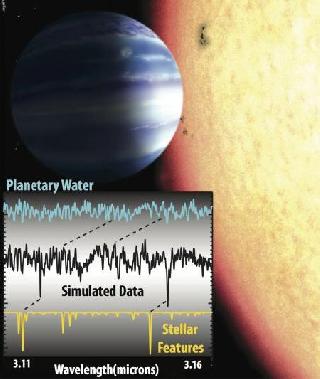
Simulated data showing the method used for detecting water vapour features detected around the hot Jupiter tau Bootis b. In this example, the planetary signal has been increased in strength by several orders of magnitude relative to the actual signal. The dotted lines show the blue- and red-shifts of the planetary and stellar lines in the data, respectively. Image credit: Alexandra Lockwood/Caltech
WASHINGTON (PTI): For the first time, scientists have detected water vapour in the atmosphere of a Jupiter-like planet orbiting a nearby star using a novel technique.
The new technique could help researchers learn about how many planets with water - like Earth - exist within our galaxy, researchers said.
Researchers at The California Institute of Technology (Caltech) and several other institutions analysed the gaseous atmospheres of such extrasolar planets and have made the first detection of water in the atmosphere of the Jupiter-mass planet orbiting tau Bootis star.
Scientists have previously detected water vapour on a handful of other planets, but these detections could only take place under very specific circumstances, said Alexandra Lockwood, the first author of the study.
Lockwood and her adviser Geoffrey Blake applied a novel technique for finding water in a planetary atmosphere. Other researchers had used similar approaches previously to detect carbon monoxide in tau Bootis b.
The method utilised the radial velocity (RV) technique - a technique commonly used in the visible region of the spectrum to which our eyes are sensitive - for discovering non-transiting exoplanets.
Using the Doppler effect, RV detection traditionally determines the motion of a star due to the gravitational pull of a companion planet; the star moves opposite that of the orbital motion of the planet, and the stellar features shift in wavelength.
A large planet or a planet closer to its host star provides a larger shift.
Lockwood, Blake, and their colleagues expanded the RV technique into the infrared to determine the orbit of tau Bootis b around its star, and added further analysis of the light shifts via spectroscopy - an analysis of the light's spectrum.
Since every compound emits a different wavelength of light, this unique light signature allows the researchers to analyse molecules that make up the planet's atmosphere.
Using data of tau Bootis b from the Near Infrared Echelle Spectrograph (NIRSPEC) at the W M Keck Observatory in Hawaii, researchers were able to compare the molecular signature of water to the light spectrum emitted by the planet, confirming that the atmosphere did indeed include water vapour.
The study was published in The Astrophysical Journal Letters.
 Previous Article
Previous Article Next Article
Next Article













The Indian Air Force, in its flight trials evaluation report submitted before the Defence Ministry l..
view articleAn insight into the Medium Multi-Role Combat Aircraft competition...
view articleSky enthusiasts can now spot the International Space Station (ISS) commanded by Indian-American astr..
view article